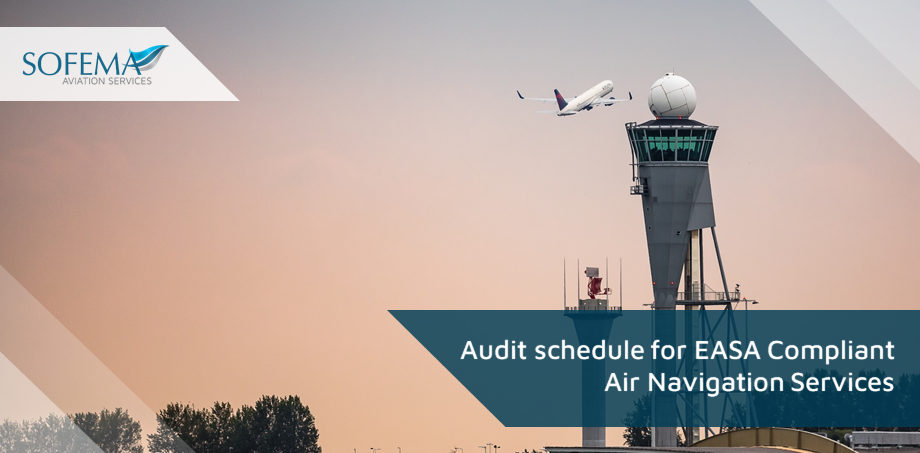Sofema Aviation Services (SAS) www.sassofia.com considers the role and purpose of a typical audit schedule for EASA Compliant Air Navigation Services.
Introduction
Developing an annual audit plan and schedule for an EASA-compliant organization requires a structured approach. Here we consider the development of an Audit Plan including Objectives, Criteria, Capacity Planning and Delivery.
Creating The Audit Schedule – Criteria Considerations:
- Ensure that the audit criteria are aligned with EASA regulations, especially Regulation (EU) 2017/373.
– The regulation outlines the duties of competent authorities in the aviation sector when they detect non-compliance in service providers.
– Auditors should be familiar with these responsibilities to ensure that their findings align with regulatory expectations.
- The audit should also consider the organization’s internal policies, procedures, and standards.
- An efficient audit schedule is pivotal to ensure that an organization is operating in full compliance with the stipulated regulations.
Audit Criteria (Regulation (EU) 2017/373)
Regular audits, as per the schedule, will ensure the organization meets both regulatory and internal standards, thereby ensuring safe and efficient operations.
To ensure total compliance, the following areas need to be considered (Hi-Level Audit Areas)
- Annex IV – Part ATS (specific requirements for providers of air traffic services)
- Annex V – Part MET (specific requirements for providers of meteorological services)
- Annex VI – Part AIS (specific requirements for the providers of aeronautical information services)
- Annex VII – Part DAT (specific requirements for providers of data services)
- Annex VIII – PART CNS (specific requirements for providers of communication, navigation, or surveillance services)
- Annex IX – Part ATFM (specific requirements for providers of air traffic flow management)
- Annex X – Part ASM (specific requirements for providers of airspace management)
- Annex XI – Part FPD (specific requirements for providers of flight procedure design services)
- Annex XII – Part NM (specific requirements for the network manager)
- Annex XIII – Part PERS (requirements for service providers concerning personnel training and competence assessment)
Specific Details to be Checked – Generic (Applicable to each of the above areas)
- Validation of licenses.
- Certifications, and other necessary documentation.
- Checking adherence to responsibilities laid out by the competent authorities.
- Validation of any actions taken post-detection of non-compliance by service providers.
- Organization’s Internal Policies & Procedures:
– Ensure procedures are documented and updated.
– Confirm that operational procedures meet regulatory standards.
– Check the efficiency of communication and implementation of procedures.
- Verification that policies align with EASA regulations.
- Review of any changes or updates to internal policies.
- Assess if the policies are effectively communicated within the organization.
- Organization’s Internal Standards
– Verification that standards align with both internal policies and EASA regulations.
– Ensuring consistency and uniformity in applying standards.
– Evaluating effectiveness and relevance of standards in current operational scenarios.
- Training and Competency
– Training Records
– Ensure all staff members have received the necessary training.
– Check if training is up-to-date with the current regulations and internal policies.
– Review effectiveness and feedback from training sessions.
- Staff Competency
– Ensure staff certifications and qualifications are up-to-date.
– Review any reported incidents or breaches related to staff competency.
– Evaluate ongoing staff development and training programs.
- Safety and Risk Management
– Ensure all safety protocols are documented and adhered to.
– Review any reported safety incidents.
– Evaluate the effectiveness of safety drills and mock scenarios.
- Risk Management Strategies
– Evaluate the organization’s risk assessment methodologies.
– Review actions taken for identified risks.
– Ensure risk management aligns with both internal and EASA standards.
- Equipment and Infrastructure
– Maintenance Records
– Ensure all equipment is maintained in line with the manufacturer’s and regulatory guidelines.
– Review any equipment failures or malfunctions.
– Check the efficiency of maintenance schedules and protocols.
- Infrastructure Compliance
– Review infrastructure for wear and tear.
– Ensure infrastructure meets regulatory and safety standards.
– Validate any modifications or changes made to the infrastructure.
Safety & Quality Key Audit Check Areas:
- Review the organization’s safety policy to ensure it’s in line with EASA requirements.
- Check if it’s communicated effectively throughout the organization and if there’s a clear commitment from top management.
- Examine the processes in place for hazard identification and risk assessment.
- Ensure that there are effective measures to mitigate identified risks.
- Check the mechanisms in place to ensure that safety management activities are effective.
– This includes monitoring and measurement of safety performance.
- Review training programs, communication strategies, and other initiatives aimed at promoting a positive safety culture.
- Ensure that there are processes in place for monitoring and improving the quality of products or services.
– This includes regular reviews, feedback mechanisms, and continuous improvement initiatives.
- Non-compliance and Corrective Actions – Examine the procedures for detecting non-compliance, reporting, and ensuring corrective actions are taken.
– Ensure that these align with the requirements of Regulation (EU) 2017/373.
Continuous Improvement:
- Establish a mechanism to gather feedback from the audited departments or processes.
- Periodically review the audit findings to identify trends, recurring issues, or areas that need more focus in future audits.
- Ensure that auditors are regularly trained and updated on the latest EASA regulations and industry best practices.
Stakeholder Engagement:
- Maintain open channels of communication with all stakeholders, including top management, department heads, and frontline staff. This ensures buy-in and support for the audit process.
- Regularly update stakeholders on the audit findings, recommendations, and any corrective actions taken.
Next Steps
Follow this link to our Library to find & download related documents for Free.
Please see the following course EASA Quality Assurance Auditing Introduction for Air Navigation Services (ANS)
Visit our websites www.sassofia.com and www.sofemaonline.com or email team@sassofia.com
Tags:
Air Navigation, Air Navigation Services, Audit Checklists, Audit Criteria, EASA, EASA Compliant Audit Services, Safety & Quality Key Audit Check Areas, SAS blogs




